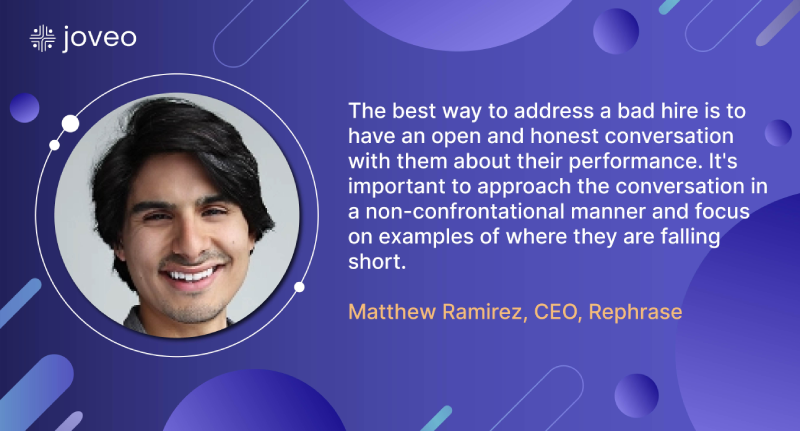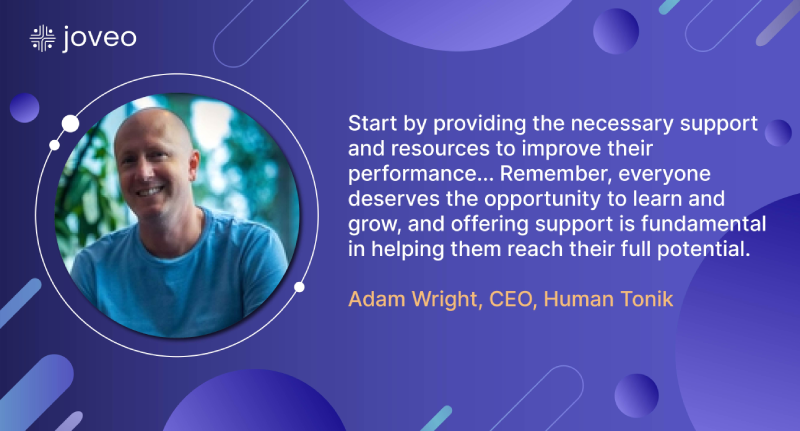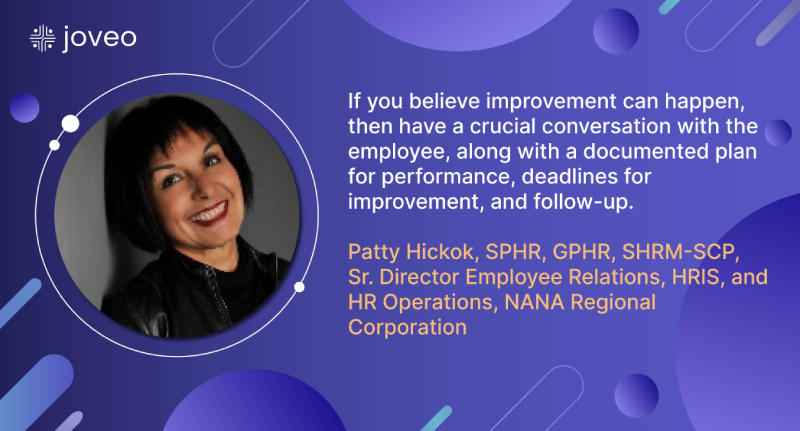Dealing with a “wrong hire” can be a challenging situation for any organization. To help you navigate this issue, we’ve gathered insights from 10 HR leaders and professionals, offering advice ranging from addressing performance through conversation to considering alternative company placements. Learn from their expertise and find the best approach to handle a “wrong hire” in your organization.
Address Performance Through Conversation
I have hired many employees over the years, and, unfortunately, I have also had to deal with several bad hires. The best way to address a bad hire is to have an open and honest conversation with them about their performance. It’s important to approach the conversation in a non-confrontational manner and focus on examples of where they are falling short.
Before having this conversation, it’s also essential to ensure that you have given the employee clear expectations and provided them with the necessary tools and resources to succeed. If they are still struggling despite your efforts to support them, it may be time to consider letting them go.
However, before making that decision, it’s important to also consider if there are any underlying issues that may be contributing to their poor performance. For example, they may be struggling with a personal issue or may not be a good fit for their current role. In these cases, it may be possible to find a better-suited role within the company.
Matthew Ramirez, CEO, Rephrase

Offer Support and Resources
When dealing with a “bad hire,” start by providing the necessary support and resources to improve their performance and succeed in their role. This could involve offering additional training programs or workshops tailored to their needs.
Provide access to mentorship or coaching opportunities, where experienced colleagues can offer guidance and share their expertise. Equipping them with relevant tools, such as software or resources, can also aid their progress.
When you demonstrate a genuine commitment to their success, you show them that you value their growth as an employee. This support helps foster a positive environment of continuous learning and improvement, encouraging them to strive for better results and increasing their chances of becoming a valuable asset to the organization.
Remember, everyone deserves the opportunity to learn and grow, and offering support is fundamental in helping them reach their full potential.
Adam Wright, CEO, Human Tonik

Document Issues and Be Patient
The best way I have handled a “bad hire” is to let the situation work itself out.
Once I realize an employee isn’t a great fit for the office, I start documenting every negative encounter that occurs. I document all conversations about any issues that go against company policy or are negative in any way. I make sure that the employee signs each piece of paper that summarizes the conversations that are had, and eventually, I accumulate enough data to let them go without being fearful of unemployment claims, etc.
In these situations, I have found that patience is key; it is all about accumulating the necessary paperwork to prove the situation.
Kat Woods, Plastic Surgery Practice Manager/Operating Room Manager, Avante Plastic Surgery
Utilize Probationary Periods
No matter how carefully and effectively you screen candidates, the occasional bad hire is unavoidable. Usually, it quickly becomes obvious when a mis-hire occurs, as bad hires cannot maintain the illusion of competence for long.
This makes probationary periods in employment contracts vital, giving organizations the right to terminate employment contracts within a fixed period, usually the first six months. Almost all bad hires will reveal themselves within the first six months of their employment, giving organizations much-needed flexibility.
Naturally, employers shouldn’t just give up on new hires as soon as they start to struggle, but probationary periods provide plenty of time to thoroughly evaluate their performance and act in the best interests of everyone involved.
Chloe Yarwood, HR Manager, Test Partnership
Create Improvement Plans and Collaborate with HR
Well, you did it! Your hire is a poor fit and you are embarrassed. Should you pretend nothing’s wrong? Real leadership calls for acknowledging the situation and timely intervention.
You start by documenting the problems and whether they could be improved and how. Every situation is different and needs to be evaluated accordingly. If you believe improvement can happen, then have a crucial conversation with the employee, along with a documented plan for performance, deadlines for improvement, and follow-up. Hopefully, that will work.
However, sometimes this doesn’t end in the desired outcome, or you decided from the beginning that ending the employment relationship is the best path. If so, collaborate with HR/legal to facilitate the termination, minimize risk to the organization, and ensure the employee is treated with dignity and respect through this process.
This will be a hard decision, but one that will no longer impact the organization, you as the manager, or team morale.
Patty Hickok, SPHR, GPHR, SHRM-SCP, Sr. Director Employee Relations, HRIS, and HR Operations, NANA Regional Corporation

Enhance the Onboarding Process
One of the best ways to handle a “bad hire” as an HR leader is through an effective onboarding process. It’s essential to create an environment that empowers the new hire to adapt quickly and blend into the company culture.
I remember once we hired someone who initially struggled to fit in. Rather than categorizing them as a “bad hire,” we doubled down on our onboarding efforts. We provided clearer role expectations, increased their training, and assigned them a mentor within the team.
With this personalized approach, the new hire eventually started to flourish and became a valuable member of the team. This experience taught me that sometimes, what seems like a “bad hire” might just be a mismatch in expectations or a lack of clarity and guidance in the early stages of employment.
Alexandru Contes, Co-founder, ReviewGrower
Set Measurable Goals and Accountability
If you decide to keep the bad hire, you’ll need an improvement plan. The plan should include tangible and measurable goals with timelines.
Explain to the employee what is expected of them, and offer guidance and support as needed. Most importantly, follow up on progress and ensure employees understand they’re being held accountable for their performance. This way, you can objectively review their progress over time to gauge whether or not they’re meeting your expectations. If there isn’t any improvement after a certain point, then it might be time to move on.
Karl Robinson, CEO, Logicata
Identify Problems and Seek Solutions
Firstly, identify why they are perceived as a “bad” hire. Could it be capability? Can this be solved with further training and understanding?
Maybe it is performance. Have you approached them about this? What is the reason for their poor behavior/performance? Can you support the changes needed?
Whatever the problem is, you are best spending time looking at valid and realistic solutions. Start to implement these and closely monitor if they have been successful.
Lastly, always communicate with the hire. Let them know about your concerns and ask them to be involved in the process.
Ashlea Harwood, Associate Director (HR), Darwen Electrical Services Ltd
Understand the Root Cause
Addressing an unsuitable hire requires a strategic and thoughtful approach. It is crucial to define the traits and behaviors that categorize a hire as ineligible within the organization. This brings clarity to the recruitment team and candidates, serving as a preventive measure too.
Once the wrong hire is identified, understanding the root causes like underperformance, skill gaps, or attitude-related issues is essential. Pinpointing these reasons enables organizations to take actionable steps to rectify the situation, such as providing additional training and support, adjusting performance expectations, or exploring alternative roles.
Upon realizing that the hiring decision was not the right fit, open and honest communication should be engaged. Offering support during the transition period is crucial, with guidance from the manager. By handling this empathetically and professionally, organizations can mitigate the potential negative impact on both the candidate and the company’s reputation.
Shruti Nayak, Principal Associate and Head – Assessment Practice, Naman Integrated Management Services Pvt. Ltd
Consider Alternative Company Placements
Once you realize you made a mistake in your hiring decision, you must find a way to mitigate the adverse effects of this challenging situation. Terminating the new joiner should be a worst-case scenario, implemented when all other efforts fail.
Transition is the key to handling the problem. The best way to address these unfortunate circumstances is to ask yourself whether there is a better place for this person within your company’s structure.
To do so, identify the problem. Is it a lack of competence of the new hire that turns out to be inadequate? If so, reassess their skills and consider offering them other open vacancies. You may have overseen some of their abilities which could be a huge advantage for another department.
Or perhaps their behaviors don’t align with the company’s cultural values? If so, you might consider moving them to another team or a different working space. After all, it could be personal animosities that affect this person’s productivity.
Martyna Szcześniak, Community Expert, MyPerfectResume
Joveo can help you get started with finding the right talent at the time, place, and cost. Request a demo of Joveo solutions today! And follow us on Twitter and LinkedIn for access to insightful, thought-provoking content.















